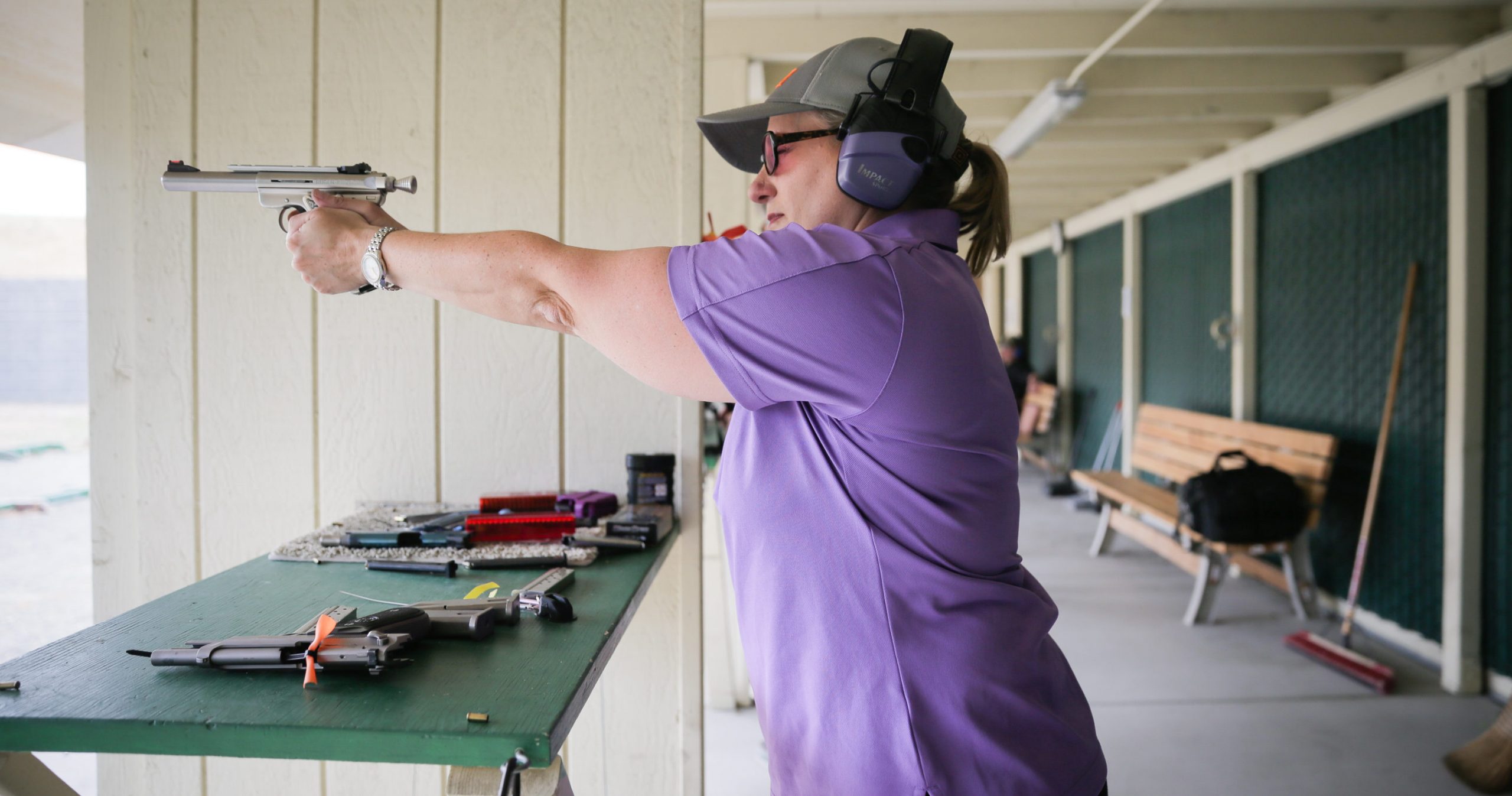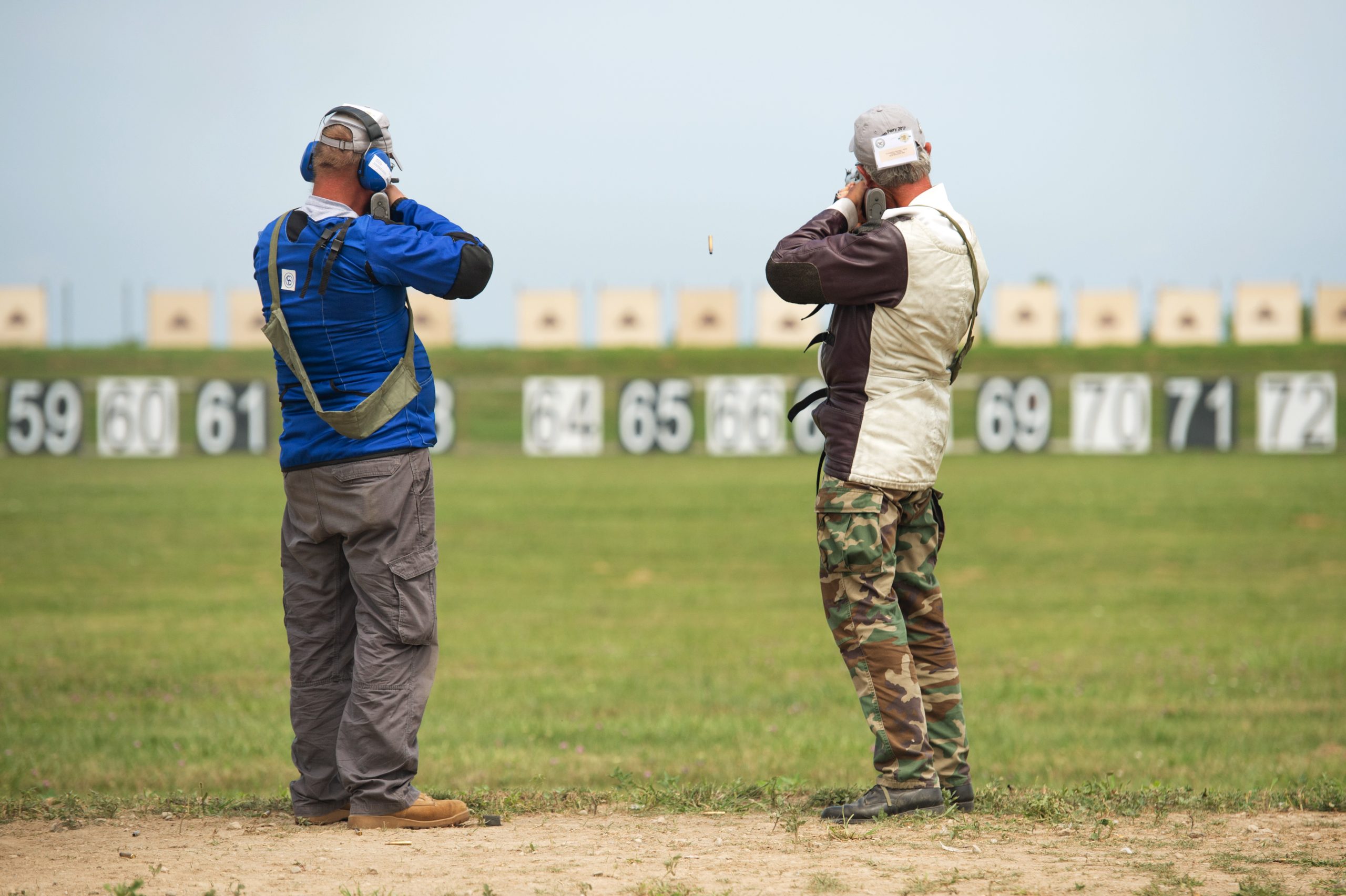Word had already spread at the Livermore Rod and Gun Club, about 50 miles east of San Francisco, that a group of self-described liberals were at the range.
“A liberal gun club. Isn’t that some kind of oxymoron?” cracked one of the shooters to another as he leaned back on a bench to rest between rounds. “Yeah,” said his friend. “I guess we could use some liberals who don’t hate guns.”
Members of The Liberal Gun Club are used to snarky remarks from other shooters. The club formed in 2009 as a loose community of gun owners who wanted to shoot and talk firearms, but were put off by the rhetoric of gun confiscation and the evils of Democrats that they often encounter at gun stores, shooting ranges, and in gun forums.
“When those people who weren’t fitting the stereotypical role would discuss firearms they’d get lambasted for their views,” says Lara Smith, the organization’s national spokesperson. “The club was started by people who said, ‘Hey, look. There’s this whole other group of people out there who shoot.’”
Jim Ridgeway served in the Navy for 23 years and now works in aircraft maintenance for a utility company. He’s held concealed-carry permits in multiple states and owns a wide array of firearms. He favors rather strict restrictions, including background checks for all gun sales. He says the NRA and allies are too cavalier about the dangers of so many people having weapons.
“I don’t feel like the NRA represents me at all, and I don’t feel like they represent their members at all,” he says. “That’s an opinion based on 30 years of observing them.”
Despite the group’s name, politics are mostly absent from its discussion boards. Members instead use the forum to discuss reliability, accuracy, and cost of firearms, and to get advice.
Liberal Gun Club members tend to support universal background checks and other efforts intended to keep weapons out of the hands of criminals. Yet they also feel that many gun laws, especially those that single out specific types of weapons, are ineffective. Some members have concealed-carry permits, and feel that fellow progressives too often don’t recognize that there are legitimate uses of guns for sport and self-defense.
Smith said the club has seen substantial growth in the last year, driven by people who have defected from the NRA, or who are otherwise put off by what they perceive as extreme rhetoric from other gun owners. The group has nine chapters and boasts about 5,000 members in all 50 states. A membership costs $10 a year.
The Northern California chapter is particularly active, with members meeting regularly at the Richmond Rod and Gun Club and other local facilities to shoot.
On a recent Saturday afternoon, Cole Smith-Crowley, an Army veteran and law student at the University of California’s Hastings College of Law in San Francisco, is taking a break from a target shooting session to analyze his shot pattern, squinting through his aviator sunglasses and pointing at where he was accurate — and where he was less so.
He shows off his pistol, a Sig Sauer P226. He points out the anchor engraving that honors the weapon’s role as the official sidearm of Navy Seals. He then launches into a monologue about the handguns he’s modified, and why; and about others he’s built himself. He espouses the merits of more unusual guns in his collection, including a multicolored Sig Sauer P938 that’s built small for concealed carry.
“I’m definitely a firearm geek, and so are a lot of the other club members,” he says.
Smith is shooting in the stall next to him. Like other club members, she shoots competitively. When not on the range or competing at shooting events, she makes her living as an attorney in the Bay Area. She also teaches basic firearm skills and defensive-use classes.
The club is expanding its ranks of certified instructors, in order to give people more options outside of classes offered by the NRA. The NRA has used its training courses to help spread its way of thinking.
“The Liberal Gun Club sees itself as one of the many groups forming to fill a niche left by the NRA’s hard-right and racist policies,” Smith said. “We anticipate rapid growth over the next two years and have no upward limit on what we’d like to achieve.”
Gun owners trend white, male, rural, and Republican. But they are not a monolithic group.
Twenty percent of respondents to a Pew Research Center survey released in June who identified as a Democrat or Democratic-leaning said they own a firearm. Pew also found that 52 percent of NRA members support background checks for private sales, a position that the organization’s legislative wing vehemently opposes.
Smith and other Liberal Gun Club members say they joined at least partly as a reaction to the rhetoric they heard from the NRA. Smith says she was repulsed by an NRA video featuring the spokesperson Dana Loesch that hinted at a culture war against liberals, elites, and the media with a “closed fist of truth.”
“That video is horrendous,” Smith says. “You’re really going to alienate people on that large of a scale?”
Gun culture, at large, can be alienating, members say.
Smith-Crowley discovered The Liberal Gun Club by searching online for gun groups without the political bent he disagreed with.
“Lots of forums related to firearms tend to lean very conservative,” Smith-Crowley says. ”It doesn’t matter if the forum claims it’s politically objective or not, they usually allow people to say things like, ‘Obama is a terrorist, communist, Muslim, Kenyan, Hitler, Nazi who is going to force everyone to get abortions and put us all in FEMA camps.’”
Smith-Crowley said he’s seen harassment and insults hurled at those who didn’t take the most extreme views when discussing guns. Rhetoric that stereotypes women and minorities is common.
“It really takes away from the experience of talking about guns,” he says.
California has some of the strictest gun laws in the nation, and some of those regulations give members of The Liberal Gun Club fits.
Handguns may not be sold or imported unless they’re on the state’s approved roster. The state has banned guns it identified as assault weapons since 1999. All gun sales must be processed through a licensed dealer, and Californians are limited to purchasing one handgun every 30 days. County sheriffs are given discretion in how liberally to offer concealed carry permits.
Crowley-Smith echoes a common criticism of California’s many laws that attack specific aspects of firearms, like rifles with bullet buttons, which are now considered assault weapons in California. Bullet buttons require a tool to remove the magazine, which was meant to be a workaround to the classification of some rifles as assault weapons. He said this cat-and-mouse game between the Legislature and gun owners and the industry is counterproductive.
Additionally, he received an injury in the Army that makes it difficult to work lever-action or bolt-action firearms. Pump-action guns are tolerable, but semi-automatic “work fantastically for me,” he says, thanks to their gentler recoil.
He finds California’s ban on assault weapons especially objectionable. In 2000, the state expanded the list of assault weapons to include features like “a pistol grip that protrudes conspicuously beneath the action of the weapon” and “a thumbhole stock.”
Crowley-Smith said such features may have a practical benefit to sport shooting, but they’re assumed to be a component of criminal intent. “When it comes to defining is and isn’t an assault weapon, the logic behind that tends to be whatever makes shooting the firearm easier is bad,” he says.
Smith says she also objects to how law enforcement officers are exempt from the 10-day waiting period and are able to purchase guns that are not on the state’s approved roster. She says this carve-out violates her sensibility of equal treatment under the law.
Smith argues that liberals are committed to finding solutions to violent crime. In her view, the poor and racial minorities are unfairly hit with sentencing enhancements tacked on for firearms and with obstacles to getting their rights restored after a felony conviction.
Her group does not take official policy positions on specific issues. However, the organization does offer talking points that serve as a general guidepost for what most members feel about key issues.

While The Liberal Gun Club is growing, it’s going to take a larger structure and more capital to allow enthusiasts to break free of the NRA. The organization sponsors shooting competitions, gives grants to gun ranges, and has deep ties to manufacturers. An NRA membership may not be required to participate in the world of sports shooting, but the social pressure to conform can be tough to ignore.
“Many of our members are NRA members or have decided that they’re not shooting at certain clubs anymore,” Smith says. “We’re a place if you don’t want to support that organization, you can come here.”
That doesn’t mean club members avoid shooters with different views. Everyone I spoke with said they regularly interact with more conservative gun owners.
“Even with the hardcore right wingers, there’s a respect,” Ridgeway says. “When you’re at the range you’re honing your skills, and there’s a certain respect amongst firearms enthusiasts.”
When Smith and Smith-Crowley were placing stickers to cover the holes they blasted through their targets, they ribbed one another over errant shots and complemented their near bull’s eyes.
Then, it was back to the firing line.



